Giochi dell'Oca e di percorso
(by Luigi Ciompi & Adrian Seville)
(by Luigi Ciompi & Adrian Seville)

|
Giochi dell'Oca e di percorso
(by Luigi Ciompi & Adrian Seville) |

|
 |

Torna alla ricerca giochi (back to game search) |
 |
| New (The) Game of the Monkey | ||
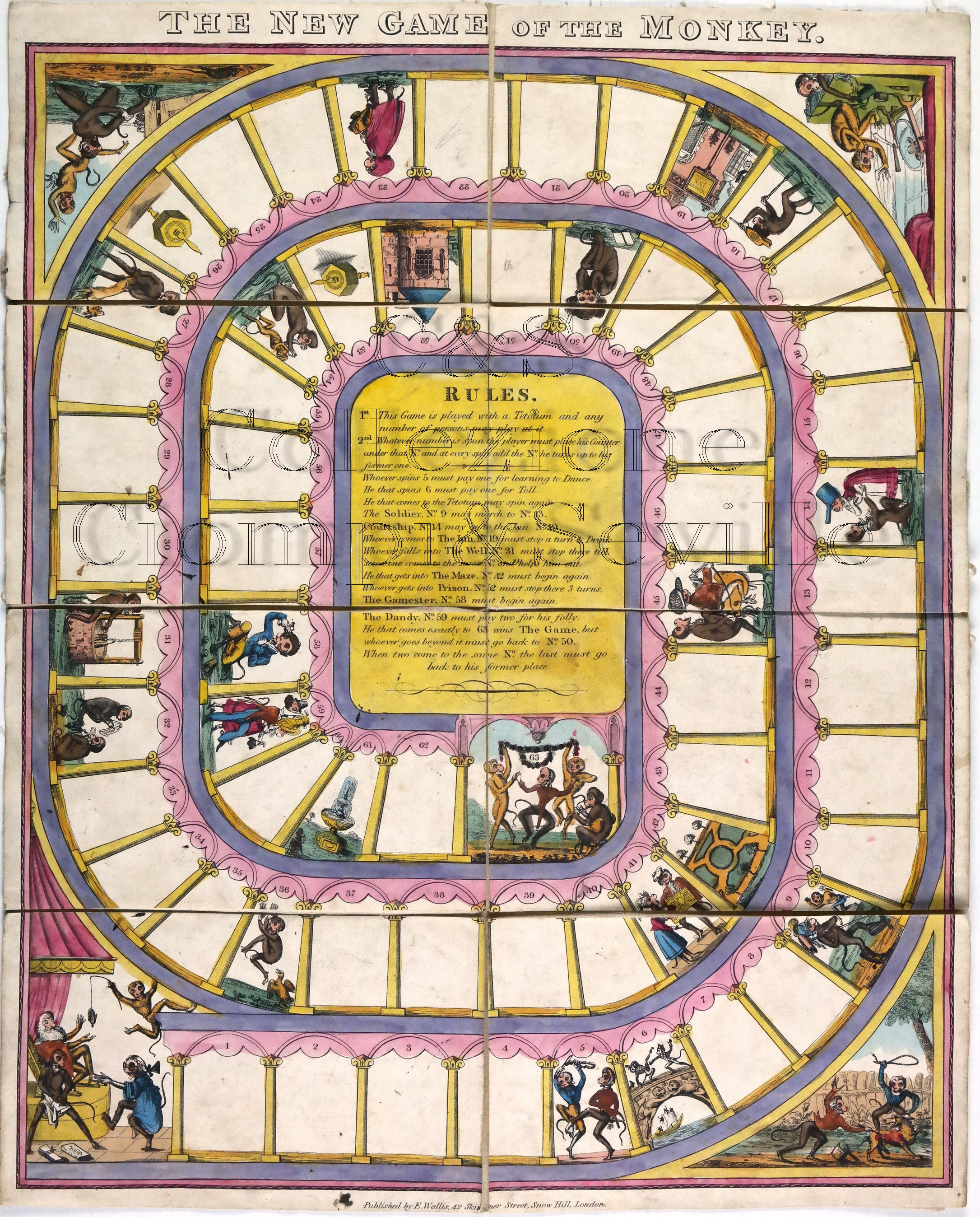 |
Versione stampabile
 |
Invia una segnalazione

|
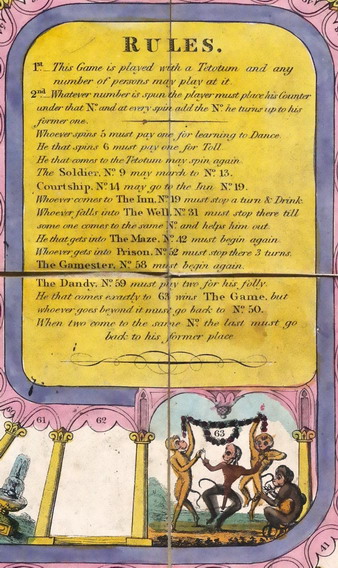 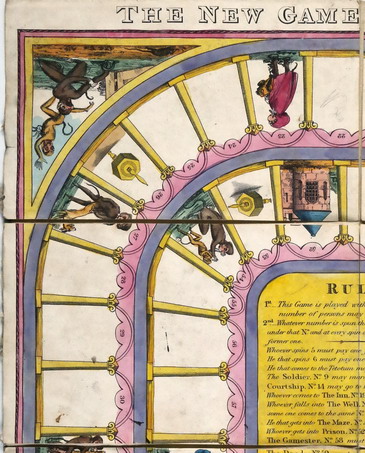 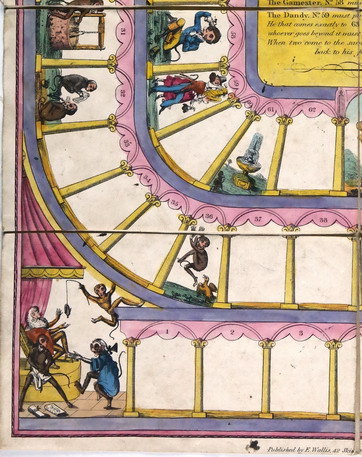 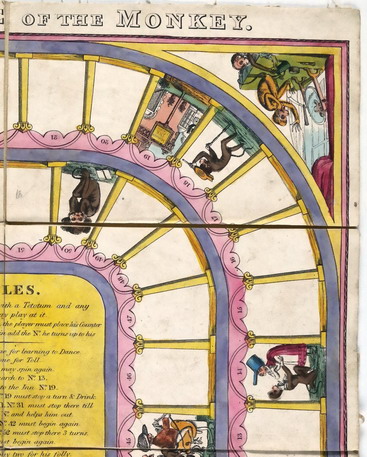 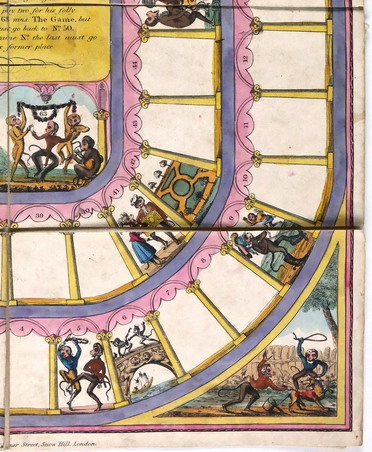 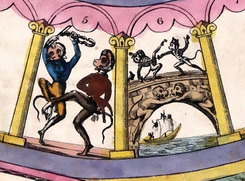 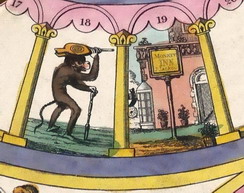 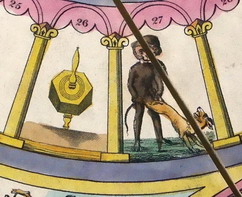 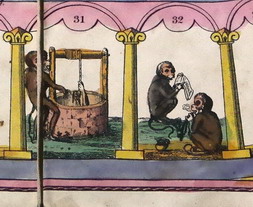 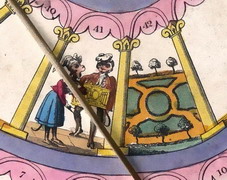 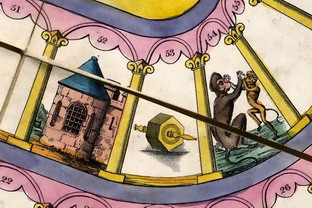 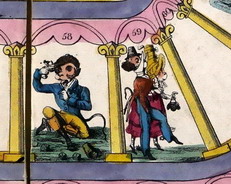 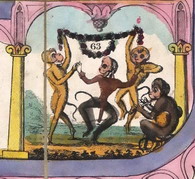 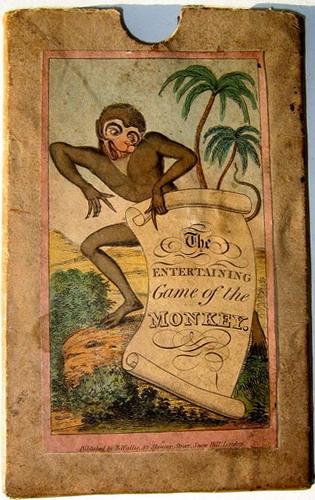 |
primo autore: | Anonimo |
| secondo autore: | Wallis | |
| anno: | 1820ca | |
| luogo: |
Inghilterra-Londra |
|
| periodo: | XIX secolo (1°/4) | |
| percorso: | Percorso di 63 caselle numerate | |
| materiale: | carta incollata su tela (engraving on paper with linen backing) | |
| dimensioni: | 460X370 | |
| stampa: | Litografia colorata a mano (hand-coloured engraving) | |
| luogo acquisto: | ||
| data acquisto: | ||
| dimensioni confezione: | ||
| numero caselle: | 63 | |
| categoria: | Mondo animale e vegetale | |
| tipo di gioco: | Gioco oca variante | |
| editore: | Published by E. Wallis, 42 Skinner Street, Snow Hill, London. | |
| stampatore: | Published by E. Wallis, 42 Skinner Street, Snow Hill, London. | |
| proprietario: | Collezione A. Seville | |
| autore delle foto: | A. Seville | |
| numero di catalogo: | 1018 | |
| descrizione: |
Gioco di 63 caselle numerate, spirale, antiorario, centripeto, verticale. Al posto delle oche ci sono le scimmie. Questo gioco della scimmia è inglese. Il "Nuovo Gioco della Scimmia" può inizialmente sembrare un tradizionale Gioco dell'Oca a 63 caselle, con scimmie al posto delle oche. In realtà contiene molte differenze: invece dell'usuale raddoppio del punteggio tipico delle caselle con le oche della versione classica, qui ogni singola scimmia ha regole proprie. Per esempio la Scimmia Danzante deve pagare pegno per imparare a ballare, il Soldato può avanzare alla casella 13 e il Dandy deve pagare doppio pegno per la sua follia. Le caselle degli imprevisti rimangono simili al gioco tradizionale e presentano la stessa numerazione. Al Ponte bisogna pagare pedaggio, alla Locanda ci si deve fermare un turno a bere, al Pozzo si resta fermi fino a che arriva qualcuno in soccorso mentre la casella 58 che mostra il Giocatore d'Azzardo suicida è esattamente come la casella della morte e fa quindi ripartire dall'inizio. Le decorazioni ai quattro angoli del tavoliere sono divertenti per quanto non abbiano nulla a che vedere con il gioco. Una rappresenta un giudice sconcertato da una falsa pista (un'aringa presa all'amo) mentre sul pavimento giace un libro intitolato Black (Commentaries on the Laws of England, ovvero Commento sulle leggi inglesi di Blackstone). L'angolo opposto illustra due scimmie mentre frustano un cane legato con una corda a una casseruola. Sopra, una scimmia si rimira allo specchio mentre nell'ultimo angolo un'altra è intrappolata in una tagliola, forse una implicita denuncia antischiavista. La signora corteggiata alla casella 14 indossa una pentola come cappello in modo piuttosto simile al personaggio di Pincopanco nell'illustrazione di Tenniel per "Attraverso lo specchio" di Lewis Carroll di molti anni più tardi. La scimmia alla casella 23 è vestita come Cappuccetto Rosso mentre quella alla casella 18 indossa un mantice a mo' di cappello: un meraviglioso esempio di follia inglese! REGOLE: al centro. CASELLE: mute. REFERENZA 1 WHITEHOUSE, Francis Reginald Beaman, (pag. 63): MONKEY. The New Game of. Published by E. Wallis, 42 Skinner Street, Snow Hill, London. An engraving size 14 ½ in X 18 in, hand-coloured, mounted in 8 sections on linen and contained in slip-in case with picture label on front. A race played with a tetotum from No 1, travelling anti-clockwise to the centre, 63, where the rules are printed. REFERENZA 2 Game 37: New Game of the Monkey The New Game of the Monkey. London: E[dward] Wallis, 42 Skinner Street, [c. 1818 - 47]. Copper engraving with original hand color, 46 x 37 cm., dissected and laid onto linen in 4 x 2 panels, folding into slipcase with decorative label. Refs. Ciompi/Seville 1018; Whitehouse, pp. 63 - 64. This hand-colored engraving looks at first to be a standard Goose game with monkeys instead of geese but in fact has several differences. Instead of the usual doubling of the throw, there are individual rules for monkey spaces: space 5: dancing monkeys – must pay one for learning to dance; space 9: the Soldier – may march to No. 13; space 14: courtship – may go to the Inn No. 19; space 59: the Dandy – must pay two for his folly. However, the hazard spaces are recognizably allied to those in Goose, e.g., space 6: the bridge – must pay one for toll; space 19: the Inn – must stop a turn & drink; space 31: the Well – must stop there till someone comes to the same No. and pulls him out; and space 58: the Gamester – must begin again. The corner decorations are lively. The lower left shows a judge being bemused by a red herring, while on the floor is a brief tied with tape and a book entitled ”Black …,” presumably for Blackstone’s Commentaries on English Law. The lower right shows two monkeys whipping a dog tied by a cord to a saucepan. Upper right, a monkey admires itself in a looking-glass, while on the upper left a monkey, seemingly fastened by the paw to a staple in the ground, is menaced by another – possibly an anti-slavery image? The ”lady monkey” being courted at space 14 is wearing a saucepan as a hat, possibly a reference to Hogarth’s print of the Industrious Prentice as Lord Mayor, where the saucepan cap of the swordbearer in the coach is noticed. Tenniel’s illustration of Tweedledum’s saucepan helmet in Through the Looking-Glass is, of course, much later. The monkey at space 23 looks like Red Riding Hood, while the one at space 18 is wearing a bellows as a hat. Race games having monkeys in place of the goose developed in Germany during the 18th century, which had seen the appearance in France of the singerie as a genre in art, with its appealing images of the playful monkey. In previous centuries the monkey represented the foolishness of mankind, as in, for example, the 15th century ”Monkey Cup” at the Cloisters Museum in New York, or the monkey game published by Altiero Gatti in 1588. This game is in the older tradition, with clear satirical intent. (Adrian Seville) Exhibitions: - "The Royal Game of the Goose four hundred years of printed Board Games". Exhibition at the Grolier Club, February 23 - May 14, 2016 (Prof. Adrian Seville). |
|
| bibliografia: |
1) WHITEHAUSE, F.R.B.: "Table Games of Georgian and Victorian Days", London, Peter Garnett, 1951. 2) GOODFELLOW, Caroline: "A Collector's Guide to Games and Puzzles". Secaucus, New Jersey, Chartwell Books-London, Quintet Publishing Limited 1991. 3) GOODFELLOW, Caroline: "The Development of the English Board Game, 1770-1850", in Board Games Studies 1, 1998. 4) GOODFELLOW, Caroline: "Jeux de société. Le guide du collectionneur des jeux de société depuis le XVIIIe siècle jusqu’à nos jours", (Edizione francese) Carrousel MS, 2001. 5) SEVILLE, Adrian: "The Game of Goose: and its influence on cartographical race games" Journal of the International Map Collectors' Society, Winter 2008 N°115 2008. 6) SEVILLE, Adrian: "The geographical Jeux de l'Oie of Europe." In "Belgeo" 2008 3-4 2008. 7) GOODFELLOW, Caroline: "How We Played: Games From Childhood Past", History Press, 2012. 8) QUINN, Brian - CARTWRIGHT, William: "Geographic Board Games". Geospatial Science Research 3. School of Mathematical and Geospatial Science, RMIT University, Australia. December 2014. 9) SEVILLE, Adrian: "The Royal Game of the Goose four hundred years of printed Board Games". Catalogue of an Exhibition at the Grolier Club, February 23 - May 14, 2016. 10) LIMAN, Ellen: "Georgian and Victorian Board Games: The Liman Collection", Pointed Leaf Press, 2017. 11) NORCIA, Megan A.: "Gaming Empire in Children's British Board Games, 1836-1860". Studies in Childhood, 1700 to the Present. Routledge, 2019. 12) SEVILLE, Adrian: "L'arte dei giochi da tavolo. Oltre un secolo di storia e divertimento dalla fine del Settecento all'inizio del Novecento." Edizioni White Star, 2019. 13) PARLAK, Omer Fatih: "Seafearing through the Perspective of Historic Board Games", in DGSM, Köllen Druck+Verlag, Bonn 2020. |
|
| "The Development of the English Board Game, 1770-1850" (Caroline G. Goodfellow) | ||
| Games of Amusement. "Table Games of Georgian and Victorian Days". (Francis Reginald Beaman, Whitehause) | ||
Vai alla ricerca giochi Vai all'elenco autori